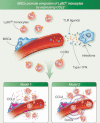Recent progress toward understanding the physiological function of bone marrow mesenchymal stem cells
- PMID: 22321024
- PMCID: PMC3403263
- DOI: 10.1111/j.1365-2567.2012.03567.x
Recent progress toward understanding the physiological function of bone marrow mesenchymal stem cells
Abstract
Mesenchymal stem cells (MSCs) are multipotent cells that are being clinically explored as regenerative therapeutics. Cultured MSCs secrete various modulatory factors, which contribute to the immunosuppressive effects of transplanted MSCs as a therapy. Although the in vitro phenotype of MSCs has been well characterized, identification of MSCs in vivo is made difficult by the lack of specific markers. Current advances in murine MSC research provide valuable tools for studying the localization and function of MSCs in vivo. Recent findings suggest that MSCs exert diverse functions depending on tissue context and physiological conditions. This review focuses on bone marrow MSCs and their roles in haematopoiesis and immune responses.
© 2012 The Author. Immunology © 2012 Blackwell Publishing Ltd.
Figures



Similar articles
-
Bone marrow Tregs mediate stromal cell function and support hematopoiesis via IL-10.JCI Insight. 2020 Nov 19;5(22):e135681. doi: 10.1172/jci.insight.135681. JCI Insight. 2020. PMID: 33208555 Free PMC article.
-
Human embryonic stem cell-derived mesenchymal stroma cells (hES-MSCs) engraft in vivo and support hematopoiesis without suppressing immune function: implications for off-the shelf ES-MSC therapies.PLoS One. 2013;8(1):e55319. doi: 10.1371/journal.pone.0055319. Epub 2013 Jan 29. PLoS One. 2013. PMID: 23383153 Free PMC article.
-
Adipogenic Mesenchymal Stromal Cells from Bone Marrow and Their Hematopoietic Supportive Role: Towards Understanding the Permissive Marrow Microenvironment in Acute Myeloid Leukemia.Stem Cell Rev Rep. 2016 Apr;12(2):235-44. doi: 10.1007/s12015-015-9639-z. Stem Cell Rev Rep. 2016. PMID: 26649729
-
Mesenchymal stem cells as therapeutics.Annu Rev Biomed Eng. 2010 Aug 15;12:87-117. doi: 10.1146/annurev-bioeng-070909-105309. Annu Rev Biomed Eng. 2010. PMID: 20415588 Free PMC article. Review.
-
Bone marrow mesenchymal stem cells: biological properties and their role in hematopoiesis and hematopoietic stem cell transplantation.Stem Cell Rev Rep. 2011 Sep;7(3):569-89. doi: 10.1007/s12015-011-9228-8. Stem Cell Rev Rep. 2011. PMID: 21249477 Review.
Cited by
-
Role of Aquaporins in the Physiological Functions of Mesenchymal Stem Cells.Cells. 2020 Dec 13;9(12):2678. doi: 10.3390/cells9122678. Cells. 2020. PMID: 33322145 Free PMC article. Review.
-
Mesenchymal stem cells from patients with rheumatoid arthritis display impaired function in inhibiting Th17 cells.J Immunol Res. 2015;2015:284215. doi: 10.1155/2015/284215. Epub 2015 Mar 31. J Immunol Res. 2015. PMID: 25918734 Free PMC article.
-
Sphingosine 1-Phosphate Receptor 2 Regulates the Migration, Proliferation, and Differentiation of Mesenchymal Stem Cells.Int J Stem Cell Res Ther. 2015;2(2):014. doi: 10.23937/2469-570x/1410014. Epub 2015 Dec 2. Int J Stem Cell Res Ther. 2015. PMID: 27275017 Free PMC article.
-
Non-Specific Inhibition of Dipeptidyl Peptidases 8/9 by Dipeptidyl Peptidase 4 Inhibitors Negatively Affects Mesenchymal Stem Cell Differentiation.J Clin Med. 2023 Jul 12;12(14):4632. doi: 10.3390/jcm12144632. J Clin Med. 2023. PMID: 37510747 Free PMC article.
-
Distinct protein signatures of acute myeloid leukemia bone marrow-derived stromal cells are prognostic for patient survival.Haematologica. 2018 May;103(5):810-821. doi: 10.3324/haematol.2017.172429. Epub 2018 Mar 15. Haematologica. 2018. PMID: 29545342 Free PMC article.
References
-
- Friedenstein AJ, Petrakova KV, Kurolesova AI, Frolova GP. Heterotopic of bone marrow. Analysis of precursor cells for osteogenic and hematopoietic tissues. Transplantation. 1968;6:230–47. - PubMed
-
- Dominici M, Le Blanc K, Mueller I, et al. Minimal criteria for defining multipotent mesenchymal stromal cells. The International Society for Cellular Therapy position statement. Cytotherapy. 2006;8:315–17. - PubMed
-
- Simmons PJ, Torok-Storb B. Identification of stromal cell precursors in human bone marrow by a novel monoclonal antibody, STRO-1. Blood. 1991;78:55–62. - PubMed
Publication types
MeSH terms
Substances
LinkOut - more resources
Full Text Sources
Other Literature Sources

